Page 49 of 72
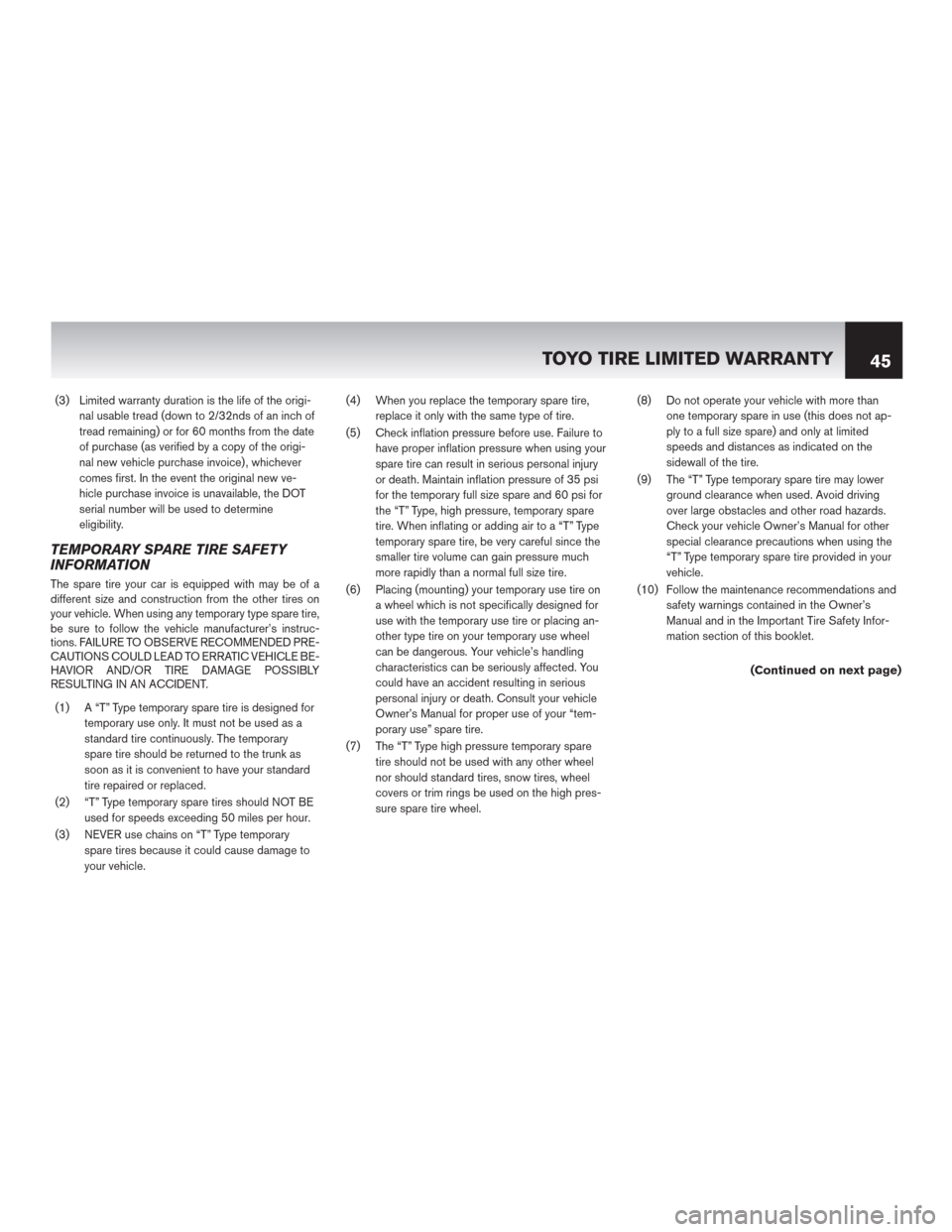
(3) Limited warranty duration is the life of the origi-
nal usable tread (down to 2/32nds of an inch of
tread remaining) or for 60 months from the date
of purchase (as verified by a copy of the origi-
nal new vehicle purchase invoice) , whichever
comes first. In the event the original new ve-
hicle purchase invoice is unavailable, the DOT
serial number will be used to determine
eligibility.
TEMPORARY SPARE TIRE SAFETY
INFORMATION
The spare tire your car is equipped with may be of a
different size and construction from the other tires on
your vehicle. When using any temporary type spare tire,
be sure to follow the vehicle manufacturer’s instruc-
tions. FAILURE TO OBSERVE RECOMMENDED PRE-
CAUTIONS COULD LEAD TO ERRATIC VEHICLE BE-
HAVIOR AND/OR TIRE DAMAGE POSSIBLY
RESULTING IN AN ACCIDENT.
(1) A “T” Type temporary spare tire is designed for
temporary use only. It must not be used as a
standard tire continuously. The temporary
spare tire should be returned to the trunk as
soon as it is convenient to have your standard
tire repaired or replaced.
(2) “T” Type temporary spare tires should NOT BE
used for speeds exceeding 50 miles per hour.
(3) NEVER use chains on “T” Type temporary
spare tires because it could cause damage to
your vehicle.(4) When you replace the temporary spare tire,
replace it only with the same type of tire.
(5) Check inflation pressure before use. Failure to
have proper inflation pressure when using your
spare tire can result in serious personal injury
or death. Maintain inflation pressure of 35 psi
for the temporary full size spare and 60 psi for
the “T” Type, high pressure, temporary spare
tire. When inflating or adding air to a “T” Type
temporary spare tire, be very careful since the
smaller tire volume can gain pressure much
more rapidly than a normal full size tire.
(6) Placing (mounting) your temporary use tire on
a wheel which is not specifically designed for
use with the temporary use tire or placing an-
other type tire on your temporary use wheel
can be dangerous. Your vehicle’s handling
characteristics can be seriously affected. You
could have an accident resulting in serious
personal injury or death. Consult your vehicle
Owner’s Manual for proper use of your “tem-
porary use” spare tire.
(7) The “T” Type high pressure temporary spare
tire should not be used with any other wheel
nor should standard tires, snow tires, wheel
covers or trim rings be used on the high pres-
sure spare tire wheel.(8) Do not operate your vehicle with more than
one temporary spare in use (this does not ap-
ply to a full size spare) and only at limited
speeds and distances as indicated on the
sidewall of the tire.
(9) The “T” Type temporary spare tire may lower
ground clearance when used. Avoid driving
over large obstacles and other road hazards.
Check your vehicle Owner’s Manual for other
special clearance precautions when using the
“T” Type temporary spare tire provided in your
vehicle.
(10) Follow the maintenance recommendations and
safety warnings contained in the Owner’s
Manual and in the Important Tire Safety Infor-
mation section of this booklet.
(Continued on next page)
TOYO TIRE LIMITED WARRANTY45
Page 50 of 72
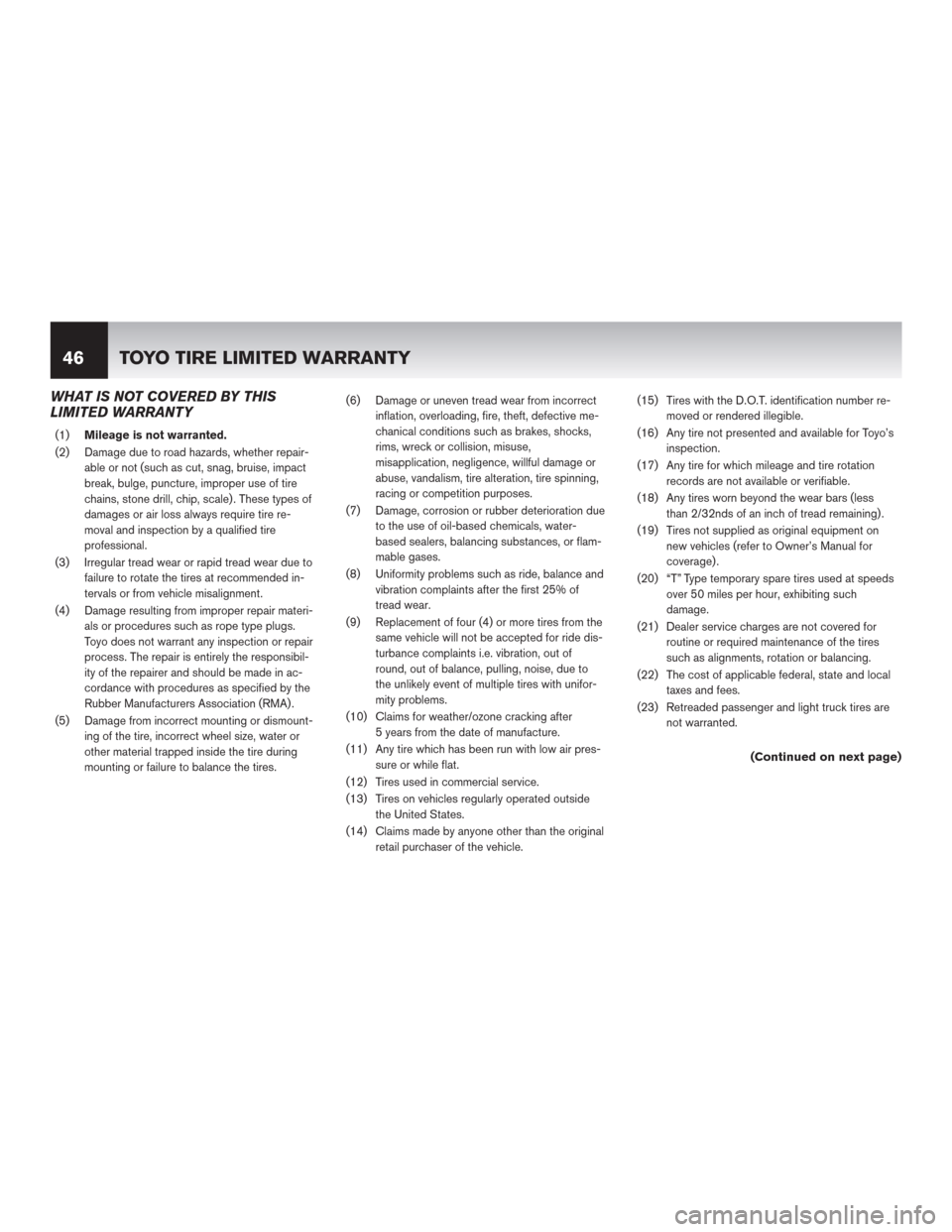
WHAT IS NOT COVERED BY THIS
LIMITED WARRANTY
(1)Mileage is not warranted.
(2) Damage due to road hazards, whether repair-
able or not (such as cut, snag, bruise, impact
break, bulge, puncture, improper use of tire
chains, stone drill, chip, scale) . These types of
damages or air loss always require tire re-
moval and inspection by a qualified tire
professional.
(3) Irregular tread wear or rapid tread wear due to
failure to rotate the tires at recommended in-
tervals or from vehicle misalignment.
(4) Damage resulting from improper repair materi-
als or procedures such as rope type plugs.
Toyo does not warrant any inspection or repair
process. The repair is entirely the responsibil-
ity of the repairer and should be made in ac-
cordance with procedures as specified by the
Rubber Manufacturers Association (RMA) .
(5) Damage from incorrect mounting or dismount-
ing of the tire, incorrect wheel size, water or
other material trapped inside the tire during
mounting or failure to balance the tires.(6) Damage or uneven tread wear from incorrect
inflation, overloading, fire, theft, defective me-
chanical conditions such as brakes, shocks,
rims, wreck or collision, misuse,
misapplication, negligence, willful damage or
abuse, vandalism, tire alteration, tire spinning,
racing or competition purposes.
(7) Damage, corrosion or rubber deterioration due
to the use of oil-based chemicals, water-
based sealers, balancing substances, or flam-
mable gases.
(8) Uniformity problems such as ride, balance and
vibration complaints after the first 25% of
tread wear.
(9) Replacement of four (4) or more tires from the
same vehicle will not be accepted for ride dis-
turbance complaints i.e. vibration, out of
round, out of balance, pulling, noise, due to
the unlikely event of multiple tires with unifor-
mity problems.
(10) Claims for weather/ozone cracking after
5 years from the date of manufacture.
(11) Any tire which has been run with low air pres-
sure or while flat.
(12) Tires used in commercial service.
(13) Tires on vehicles regularly operated outside
the United States.
(14) Claims made by anyone other than the original
retail purchaser of the vehicle.(15) Tires with the D.O.T. identification number re-
moved or rendered illegible.
(16) Any tire not presented and available for Toyo’s
inspection.
(17) Any tire for which mileage and tire rotation
records are not available or verifiable.
(18) Any tires worn beyond the wear bars (less
than 2/32nds of an inch of tread remaining) .
(19) Tires not supplied as original equipment on
new vehicles (refer to Owner’s Manual for
coverage) .
(20) “T” Type temporary spare tires used at speeds
over 50 miles per hour, exhibiting such
damage.
(21) Dealer service charges are not covered for
routine or required maintenance of the tires
such as alignments, rotation or balancing.
(22) The cost of applicable federal, state and local
taxes and fees.
(23) Retreaded passenger and light truck tires are
not warranted.
(Continued on next page)
46TOYO TIRE LIMITED WARRANTY
Page 51 of 72
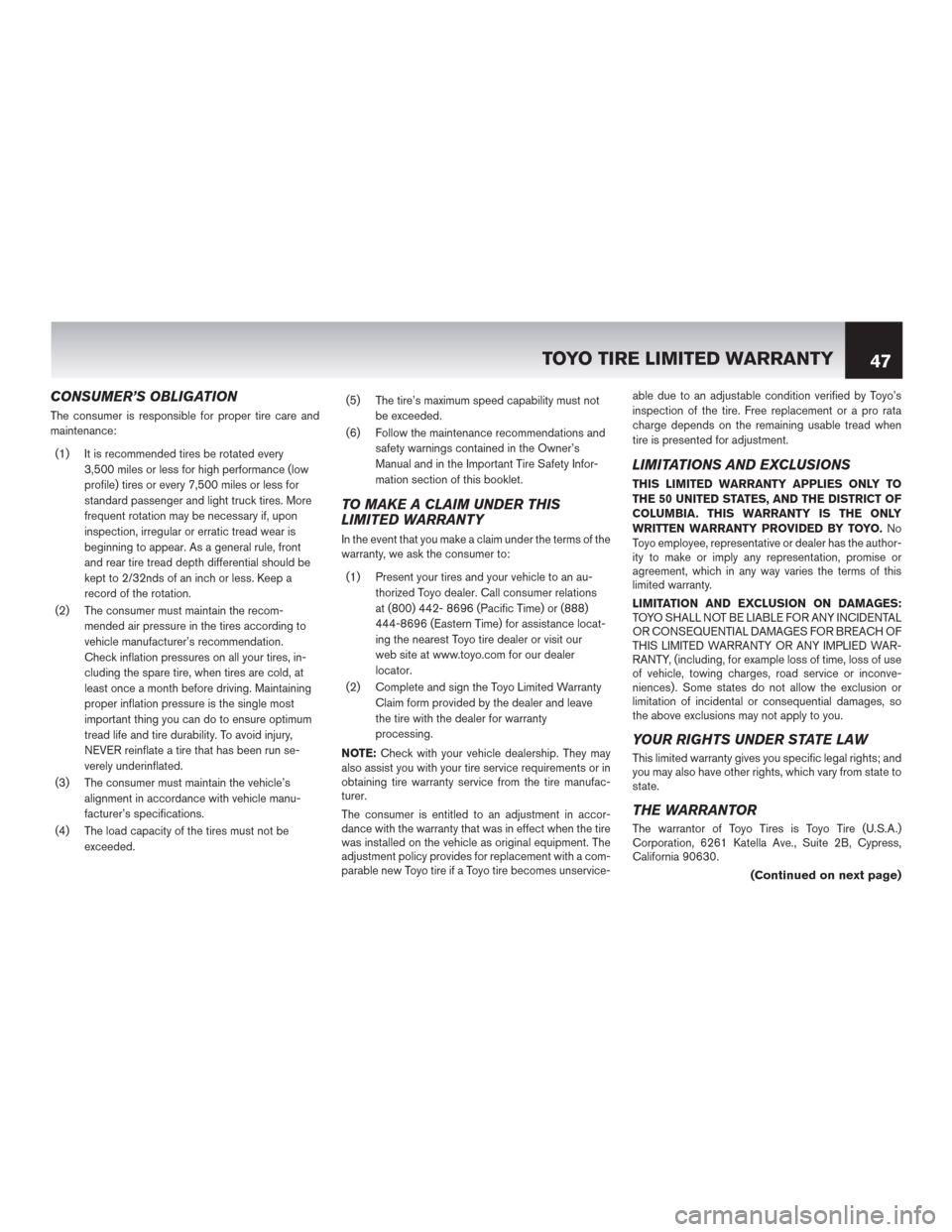
CONSUMER’S OBLIGATION
The consumer is responsible for proper tire care and
maintenance:
(1) It is recommended tires be rotated every
3,500 miles or less for high performance (low
profile) tires or every 7,500 miles or less for
standard passenger and light truck tires. More
frequent rotation may be necessary if, upon
inspection, irregular or erratic tread wear is
beginning to appear. As a general rule, front
and rear tire tread depth differential should be
kept to 2/32nds of an inch or less. Keep a
record of the rotation.
(2) The consumer must maintain the recom-
mended air pressure in the tires according to
vehicle manufacturer’s recommendation.
Check inflation pressures on all your tires, in-
cluding the spare tire, when tires are cold, at
least once a month before driving. Maintaining
proper inflation pressure is the single most
important thing you can do to ensure optimum
tread life and tire durability. To avoid injury,
NEVER reinflate a tire that has been run se-
verely underinflated.
(3) The consumer must maintain the vehicle’s
alignment in accordance with vehicle manu-
facturer’s specifications.
(4) The load capacity of the tires must not be
exceeded.(5) The tire’s maximum speed capability must not
be exceeded.
(6) Follow the maintenance recommendations and
safety warnings contained in the Owner’s
Manual and in the Important Tire Safety Infor-
mation section of this booklet.
TO MAKE A CLAIM UNDER THIS
LIMITED WARRANTY
In the event that you make a claim under the terms of the
warranty, we ask the consumer to:
(1) Present your tires and your vehicle to an au-
thorized Toyo dealer. Call consumer relations
at (800) 442- 8696 (Pacific Time) or (888)
444-8696 (Eastern Time) for assistance locat-
ing the nearest Toyo tire dealer or visit our
web site at www.toyo.com for our dealer
locator.
(2) Complete and sign the Toyo Limited Warranty
Claim form provided by the dealer and leave
the tire with the dealer for warranty
processing.
NOTE:Check with your vehicle dealership. They may
also assist you with your tire service requirements or in
obtaining tire warranty service from the tire manufac-
turer.
The consumer is entitled to an adjustment in accor-
dance with the warranty that was in effect when the tire
was installed on the vehicle as original equipment. The
adjustment policy provides for replacement with a com-
parable new Toyo tire if a Toyo tire becomes unservice-able due to an adjustable condition verified by Toyo’s
inspection of the tire. Free replacement or a pro rata
charge depends on the remaining usable tread when
tire is presented for adjustment.
LIMITATIONS AND EXCLUSIONS
THIS LIMITED WARRANTY APPLIES ONLY TO
THE 50 UNITED STATES, AND THE DISTRICT OF
COLUMBIA. THIS WARRANTY IS THE ONLY
WRITTEN WARRANTY PROVIDED BY TOYO.No
Toyo employee, representative or dealer has the author-
ity to make or imply any representation, promise or
agreement, which in any way varies the terms of this
limited warranty.
LIMITATION AND EXCLUSION ON DAMAGES:
TOYO SHALL NOT BE LIABLE FOR ANY INCIDENTAL
OR CONSEQUENTIAL DAMAGES FOR BREACH OF
THIS LIMITED WARRANTY OR ANY IMPLIED WAR-
RANTY, (including, for example loss of time, loss of use
of vehicle, towing charges, road service or inconve-
niences) . Some states do not allow the exclusion or
limitation of incidental or consequential damages, so
the above exclusions may not apply to you.
YOUR RIGHTS UNDER STATE LAW
This limited warranty gives you specific legal rights; and
you may also have other rights, which vary from state to
state.
THE WARRANTOR
The warrantor of Toyo Tires is Toyo Tire (U.S.A.)
Corporation, 6261 Katella Ave., Suite 2B, Cypress,
California 90630.
(Continued on next page)
TOYO TIRE LIMITED WARRANTY47
Page 52 of 72

FOR ASSISTANCE
Contact your authorized Toyo Tire retailer or call
Toyo Tire Consumer Relations at (800) 442-8696
(Pacific Time) or (888) 444-8696 (Eastern Time)
Monday through Friday 8:00 am to 4:45 pm.
IMPORTANT SAFETY AND
MAINTENANCE INFORMATION!
Any tire, no matter how well constructed, can fail as a
result of punctures, impact damage, improper inflation
or other conditions resulting from use. Tire failures may
create a risk of property damage or personal injury. To
reduce the risk of tire failure, we strongly recommend
the following:
WARNING!
SERIOUS INJURY MAY RESULT FROM:
(1) Tire failure due to underinflation, vehicle over-
loading or use in excess of legal speeds – fol-
low Owner’s Manual and tire data placard in
your vehicle.
(2) Explosion of tire/rim assembly due to improper
mounting – only specially trained persons
should mount tires.
Refer to the tire data placard, the Owner’s Manual
and Important Tire Safety Information and instruc-
tions contained in this booklet.
48TOYO TIRE LIMITED WARRANTY
Page 53 of 72

WHO IS THE WARRANTOR
The warrantor of the tires supplied as original equip-
ment on your new Nissan vehicle is the tire manufacturer
or tire distributor of your specific tires. Nissan isNOT
the warrantor of your original equipment tires. The war-
rantor for each of the tire brands which may be installed
as original equipment on your new Nissan is listed
below.
�BFGoodrich Tires
P.O. Box 19026
Greenville, South Carolina 29602-9026
1-877-788-8899 (U.S.)
1-888-871-6666 (Canada)
�Bridgestone Firestone North American Tire
LLC
535 Marriott Dr.
Nashville, Tennessee 37214
1-800-847-3272
�Continental General Tire, Inc.
1830 McMillan Park Drive,
Fort Mill, South Carolina 29707
1-800-847-3349
1-800-461-1776(In Canada)
http://www.continentaltire.com
http://www.continentaltire.ca
http://www.generaltire.com
�Goodyear Tire & Rubber Company
(Goodyear and Dunlop Tires)
1144 E. Market Street
Akron, Ohio 44316
1-800-321-2136
�Michelin North America, Inc.
1 Parkway South
P.O. Box
19001 Greenville, South Carolina 29602-9001
1-800-TIRE HELP(1-800-847-3435) - U. S.
1-888-871-4444(Canada)
�Toyo Tire (U.S.A.) Corporation
6261 Katella Ave., Suite 2B
Cypress, California 90630
1-800-442-8696(Pacific Time)
1-888-444-8696(Eastern Time)
http://www.toyo.com
Hankook
�CORPORATE HEADQUARTERS
1450 Valley Road
Wayne, New Jersey 07470
1-973-633-9000
Toll Free 1-877-740-7000
�WEST REGIONAL OFFICE
11555 Arrow Route, Suite 105
Rancho Cucamonga, CA 91730
1-909-481-9800
Toll Free 1-800-426-8252
�Kumho Tire U.S.A. Inc.
Corporate Headquarters
10299 6th Street
Rancho Cucamonga, CA 91730
1-909-428-3338
Toll Free 1-800-44(HI) -58646(Kumho)
WHAT IS COVERED
The tire manufacturer’s warranty for the specific tires
supplied as original equipment on your vehicle may be
found on the preceding pages.
Please refer to the following pages for important
safety information.
WHAT YOU MUST DO
To obtain information on tire warranties and tire dealer
service locations or for customer service, contact the
appropriate warrantor listed above.
In order to obtain warranty service, you must present the
unserviceable tire to an authorized Nissan dealer or to
an authorized dealer of the warrantor in the United
States or Canada. Their names and addresses are listed
in your local telephone directory. Your Nissan dealer will
also assist you with your tire service requirements or in
obtaining tire warranty service from the tire manufac-
turer.
ORIGINAL EQUIPMENT TIRE LIMITED WARRANTIES49
Page 54 of 72
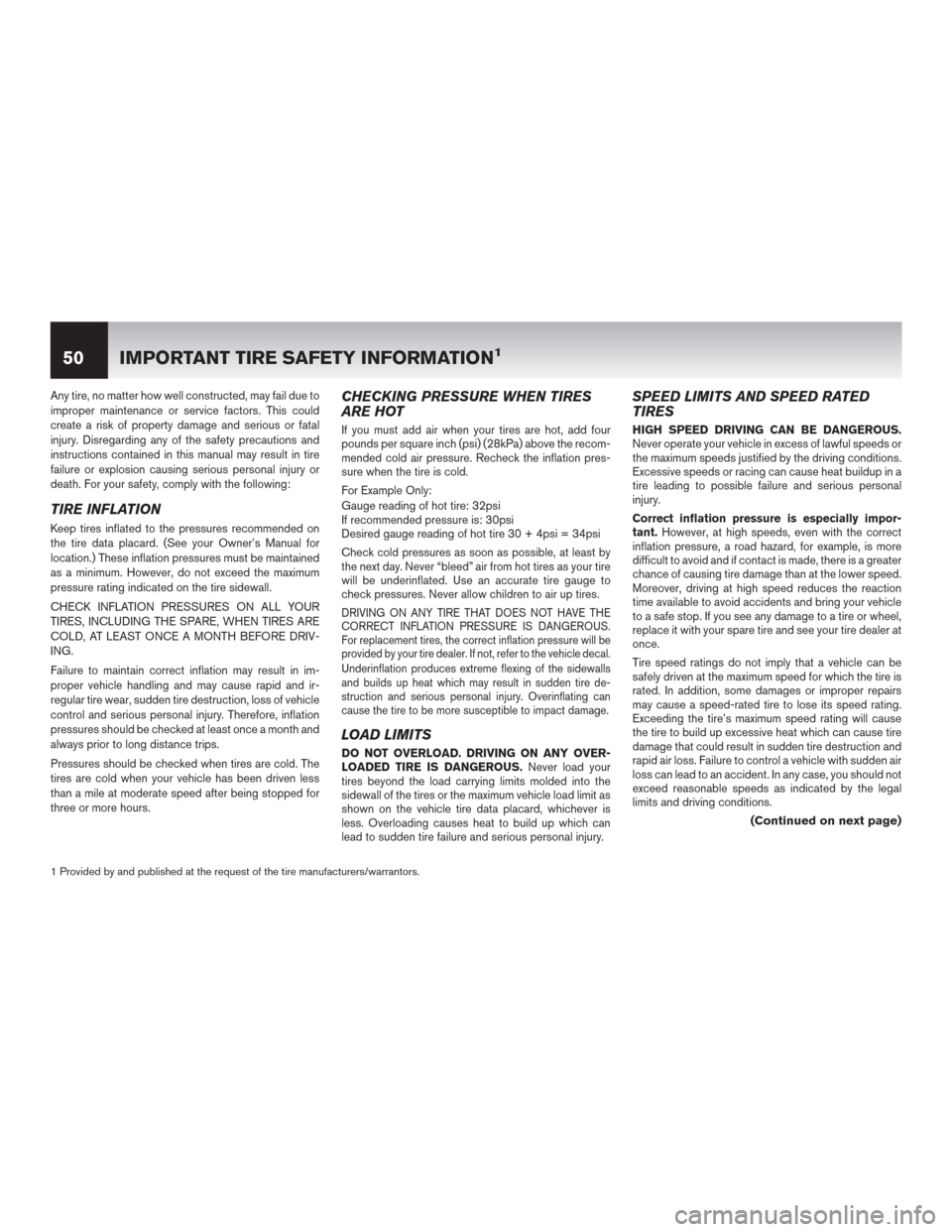
Any tire, no matter how well constructed, may fail due to
improper maintenance or service factors. This could
create a risk of property damage and serious or fatal
injury. Disregarding any of the safety precautions and
instructions contained in this manual may result in tire
failure or explosion causing serious personal injury or
death. For your safety, comply with the following:
TIRE INFLATION
Keep tires inflated to the pressures recommended on
the tire data placard. (See your Owner’s Manual for
location.) These inflation pressures must be maintained
as a minimum. However, do not exceed the maximum
pressure rating indicated on the tire sidewall.
CHECK INFLATION PRESSURES ON ALL YOUR
TIRES, INCLUDING THE SPARE, WHEN TIRES ARE
COLD, AT LEAST ONCE A MONTH BEFORE DRIV-
ING.
Failure to maintain correct inflation may result in im-
proper vehicle handling and may cause rapid and ir-
regular tire wear, sudden tire destruction, loss of vehicle
control and serious personal injury. Therefore, inflation
pressures should be checked at least once a month and
always prior to long distance trips.
Pressures should be checked when tires are cold. The
tires are cold when your vehicle has been driven less
than a mile at moderate speed after being stopped for
three or more hours.
CHECKING PRESSURE WHEN TIRES
ARE HOT
If you must add air when your tires are hot, add four
pounds per square inch (psi) (28kPa) above the recom-
mended cold air pressure. Recheck the inflation pres-
sure when the tire is cold.
For Example Only:
Gauge reading of hot tire: 32psi
If recommended pressure is: 30psi
Desired gauge reading of hot tire 30 + 4psi = 34psi
Check cold pressures as soon as possible, at least by
the next day. Never “bleed” air from hot tires as your tire
will be underinflated. Use an accurate tire gauge to
check pressures. Never allow children to air up tires.
DRIVING ON ANY TIRE THAT DOES NOT HAVE THE
CORRECT INFLATION PRESSURE IS DANGEROUS.
For replacement tires, the correct inflation pressure will be
provided by your tire dealer. If not, refer to the vehicle decal.
Underinflation produces extreme flexing of the sidewalls
and builds up heat which may result in sudden tire de-
struction and serious personal injury. Overinflating can
cause the tire to be more susceptible to impact damage.
LOAD LIMITS
DO NOT OVERLOAD. DRIVING ON ANY OVER-
LOADED TIRE IS DANGEROUS.Never load your
tires beyond the load carrying limits molded into the
sidewall of the tires or the maximum vehicle load limit as
shown on the vehicle tire data placard, whichever is
less. Overloading causes heat to build up which can
lead to sudden tire failure and serious personal injury.
SPEED LIMITS AND SPEED RATED
TIRES
HIGH SPEED DRIVING CAN BE DANGEROUS.
Never operate your vehicle in excess of lawful speeds or
the maximum speeds justified by the driving conditions.
Excessive speeds or racing can cause heat buildup in a
tire leading to possible failure and serious personal
injury.
Correct inflation pressure is especially impor-
tant.However, at high speeds, even with the correct
inflation pressure, a road hazard, for example, is more
difficult to avoid and if contact is made, there is a greater
chance of causing tire damage than at the lower speed.
Moreover, driving at high speed reduces the reaction
time available to avoid accidents and bring your vehicle
to a safe stop. If you see any damage to a tire or wheel,
replace it with your spare tire and see your tire dealer at
once.
Tire speed ratings do not imply that a vehicle can be
safely driven at the maximum speed for which the tire is
rated. In addition, some damages or improper repairs
may cause a speed-rated tire to lose its speed rating.
Exceeding the tire’s maximum speed rating will cause
the tire to build up excessive heat which can cause tire
damage that could result in sudden tire destruction and
rapid air loss. Failure to control a vehicle with sudden air
loss can lead to an accident. In any case, you should not
exceed reasonable speeds as indicated by the legal
limits and driving conditions.
(Continued on next page)
1 Provided by and published at the request of the tire manufacturers/warrantors.
50IMPORTANT TIRE SAFETY INFORMATION1
Page 55 of 72

SPEED SYMBOLS -are shown on the sidewall of
some tires. The following table shows the maximum
speed corresponding to the symbol.
SPEED RATINGS
†Speed Speed
Maximum
Ratingmph km/Hr
M 81 130
N 87 140
P 93 150
R 99 160
R 106 170
S 112 180
T 118 190
H 130 210
W 168 270
Y 186 300
V* 149 240
Z** 149 240
*Some V (or VR) rated tires may have a speed
capacity of greater than 149 mph (240 km/h).
Consult your tire manufacturer for maximum speed rat-
ings if your vehicle capability exceeds this speed.
**Z (or ZR) rated tires are designed for use on
cars with maximum speed capabilities in excess
of 149 mph (240 km/h).Consult your tire manufac-
turer for maximum speed capabilities.
†Although a tire may be speed rated, we do not endorse
the operation of any vehicle in an unsafe or unlawful
manner. Speed ratings are based on laboratory testswhich relate to performance on the road, but are not
applicable if tires are underinflated, overloaded, worn
out, damaged, altered, improperly repaired, or re-
treaded. Furthermore, tire speed ratings do not imply
that vehicles can be safely driven at the maximum speed
for which the tire is rated, particularly under adverse
road and weather conditions or if the vehicle has un-
usual characteristics. Most highway passenger tires
that do not have a speed symbol in the sidewall have a
maximum speed rating of 105 mph. Light truck highway
tires that do not have a speed symbol on the sidewall of
the tire have a maximum speed of 87 mph. Some light
truck tires may have higher maximum speeds; consult
your tire dealer. The speed and other ratings of re-
treaded tires are assigned by the retreader and voids
the original manufacturer’s ratings.
IMPORTANT:In order to maintain the speed capability
of the vehicle, replacement tires must have speed rat-
ings equal to or higher than those fitted as original
equipment (as indicated on the vehicle placard or Own-
er’s Manual) . If tires with lower speed ratings are fitted,
the speed capability of the vehicle will be lowered to the
maximum speed capability of the replacement tire as
indicated on the above table.
Remember...High speed driving can be dangerous and
may be damaging to your tires.
And...When driving at highway speeds, correct inflation
pressure is especially important.
Contact the manufacturer of your tires for their position
and assistance on the repair of speed-rated tires. When
you are replacing tires that have a speed rating, youmust replace with tires of the same or higher speed
rating if the speed capability of the vehicle is to be
maintained.
VISUAL INSPECTION
INSPECT YOUR TIRES. DO NOT DRIVE ON A
DAMAGED TIRE OR WHEEL.Check your tires fre-
quently for scrapes, bulges, separations, cuts, snags,
cracks, penetrations or excessive localized wear from
hard braking. Also check for abnormal tire wear, particu-
larly on the edges of the tire tread which may be caused
by misalignment or underinflation. Impacts can damage
the inner portion of the tire without being visible on the
outside. If damage can be seen on the tires or wheels, or
if you suspect that possible impact damage may have
occurred, replace with spare at once and have your tire
store or dealer inspect your tires immediately. Use of a
damaged tire could result in tire destruction. When
inspecting your tires, including the spare, check your air
pressures. If your pressure check indicates that one of
your tires has lost pressure of two pounds or more, look
for signs of penetrations, valve leakage, or wheel dam-
age that may account for the air loss.
All tires will wear out faster when subjected to high
speeds as well as hard cornering, rapid starts, sudden
stops, frequent driving on roads which are in poor
condition, and off-road use. Roads with holes and rocks
or other objects can damage tires and cause misalign-
ment of your vehicle. When you drive on such roads,
drive on them carefully and slowly, and before driving
again at normal or highway speeds, examine your tires
for any damage, such as cuts, bulges, penetrations,
unusual wear patterns, etc.
(Continued on next page)
IMPORTANT TIRE SAFETY INFORMATION151
Page 56 of 72
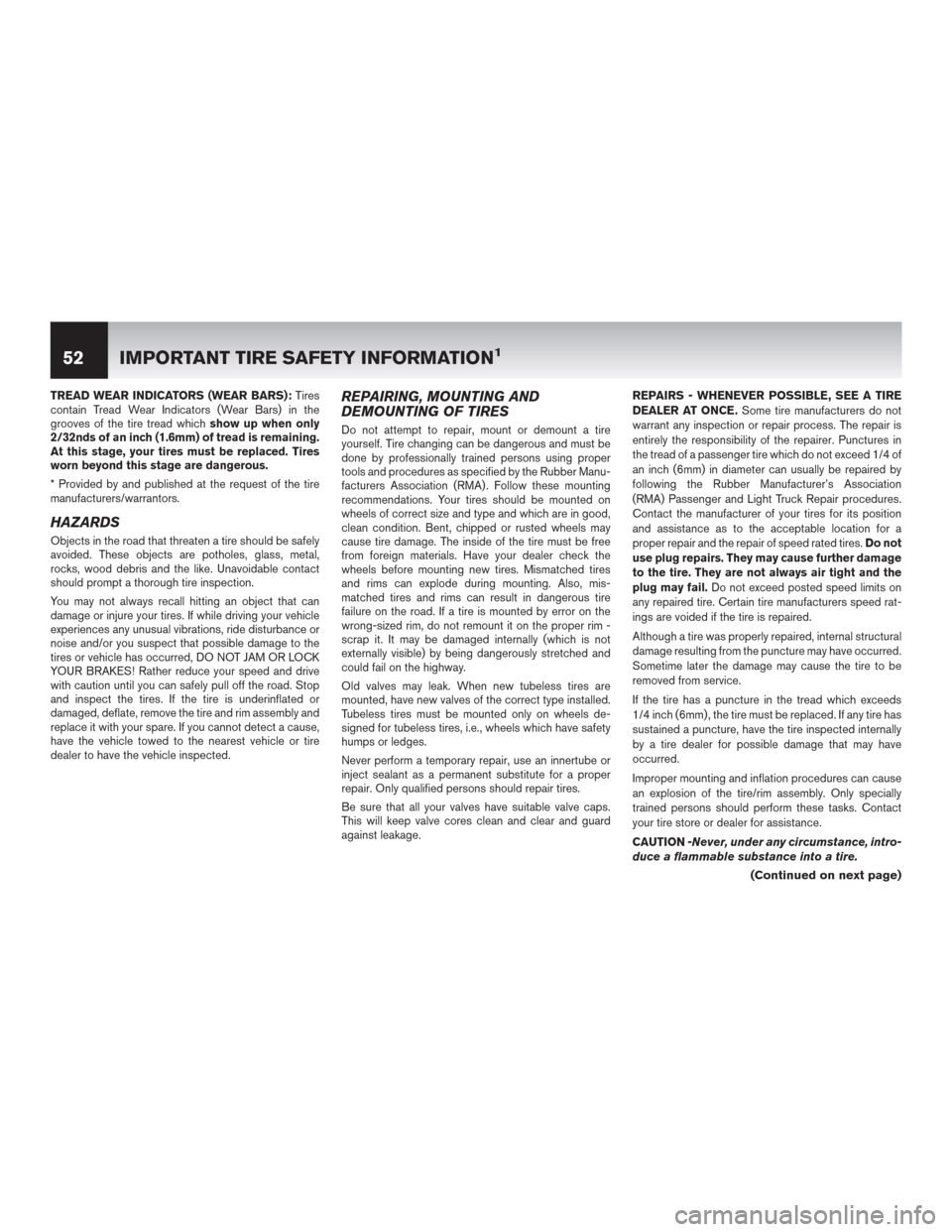
TREAD WEAR INDICATORS (WEAR BARS):Tires
contain Tread Wear Indicators (Wear Bars) in the
grooves of the tire tread whichshow up when only
2/32nds of an inch (1.6mm) of tread is remaining.
At this stage, your tires must be replaced. Tires
worn beyond this stage are dangerous.
* Provided by and published at the request of the tire
manufacturers/warrantors.
HAZARDS
Objects in the road that threaten a tire should be safely
avoided. These objects are potholes, glass, metal,
rocks, wood debris and the like. Unavoidable contact
should prompt a thorough tire inspection.
You may not always recall hitting an object that can
damage or injure your tires. If while driving your vehicle
experiences any unusual vibrations, ride disturbance or
noise and/or you suspect that possible damage to the
tires or vehicle has occurred, DO NOT JAM OR LOCK
YOUR BRAKES! Rather reduce your speed and drive
with caution until you can safely pull off the road. Stop
and inspect the tires. If the tire is underinflated or
damaged, deflate, remove the tire and rim assembly and
replace it with your spare. If you cannot detect a cause,
have the vehicle towed to the nearest vehicle or tire
dealer to have the vehicle inspected.
REPAIRING, MOUNTING AND
DEMOUNTING OF TIRES
Do not attempt to repair, mount or demount a tire
yourself. Tire changing can be dangerous and must be
done by professionally trained persons using proper
tools and procedures as specified by the Rubber Manu-
facturers Association (RMA) . Follow these mounting
recommendations. Your tires should be mounted on
wheels of correct size and type and which are in good,
clean condition. Bent, chipped or rusted wheels may
cause tire damage. The inside of the tire must be free
from foreign materials. Have your dealer check the
wheels before mounting new tires. Mismatched tires
and rims can explode during mounting. Also, mis-
matched tires and rims can result in dangerous tire
failure on the road. If a tire is mounted by error on the
wrong-sized rim, do not remount it on the proper rim -
scrap it. It may be damaged internally (which is not
externally visible) by being dangerously stretched and
could fail on the highway.
Old valves may leak. When new tubeless tires are
mounted, have new valves of the correct type installed.
Tubeless tires must be mounted only on wheels de-
signed for tubeless tires, i.e., wheels which have safety
humps or ledges.
Never perform a temporary repair, use an innertube or
inject sealant as a permanent substitute for a proper
repair. Only qualified persons should repair tires.
Be sure that all your valves have suitable valve caps.
This will keep valve cores clean and clear and guard
against leakage.REPAIRS - WHENEVER POSSIBLE, SEE A TIRE
DEALER AT ONCE.Some tire manufacturers do not
warrant any inspection or repair process. The repair is
entirely the responsibility of the repairer. Punctures in
the tread of a passenger tire which do not exceed 1/4 of
an inch (6mm) in diameter can usually be repaired by
following the Rubber Manufacturer’s Association
(RMA) Passenger and Light Truck Repair procedures.
Contact the manufacturer of your tires for its position
and assistance as to the acceptable location for a
proper repair and the repair of speed rated tires.Do not
use plug repairs. They may cause further damage
to the tire. They are not always air tight and the
plug may fail.Do not exceed posted speed limits on
any repaired tire. Certain tire manufacturers speed rat-
ings are voided if the tire is repaired.
Although a tire was properly repaired, internal structural
damage resulting from the puncture may have occurred.
Sometime later the damage may cause the tire to be
removed from service.
If the tire has a puncture in the tread which exceeds
1/4 inch (6mm) , the tire must be replaced. If any tire has
sustained a puncture, have the tire inspected internally
by a tire dealer for possible damage that may have
occurred.
Improper mounting and inflation procedures can cause
an explosion of the tire/rim assembly. Only specially
trained persons should perform these tasks. Contact
your tire store or dealer for assistance.
CAUTION -Never, under any circumstance, intro-
duce a flammable substance into a tire.
(Continued on next page)
52IMPORTANT TIRE SAFETY INFORMATION1